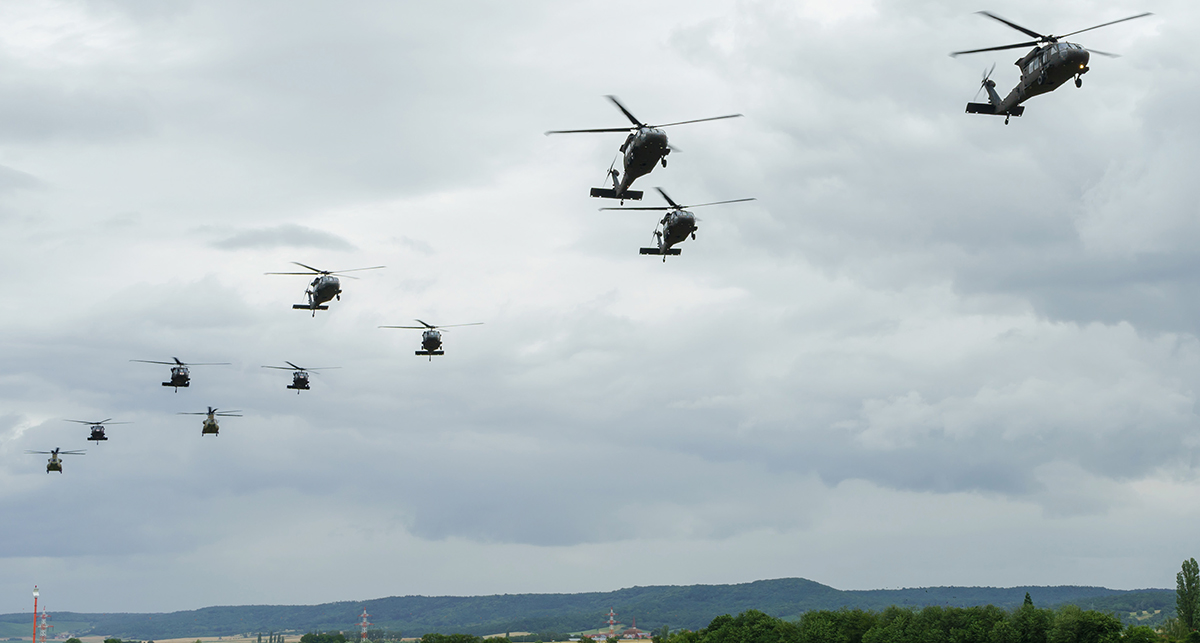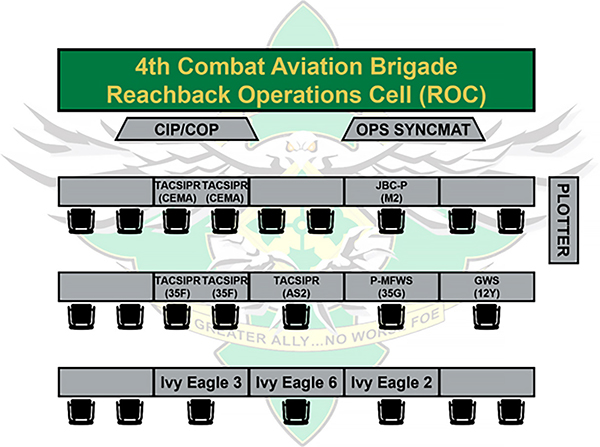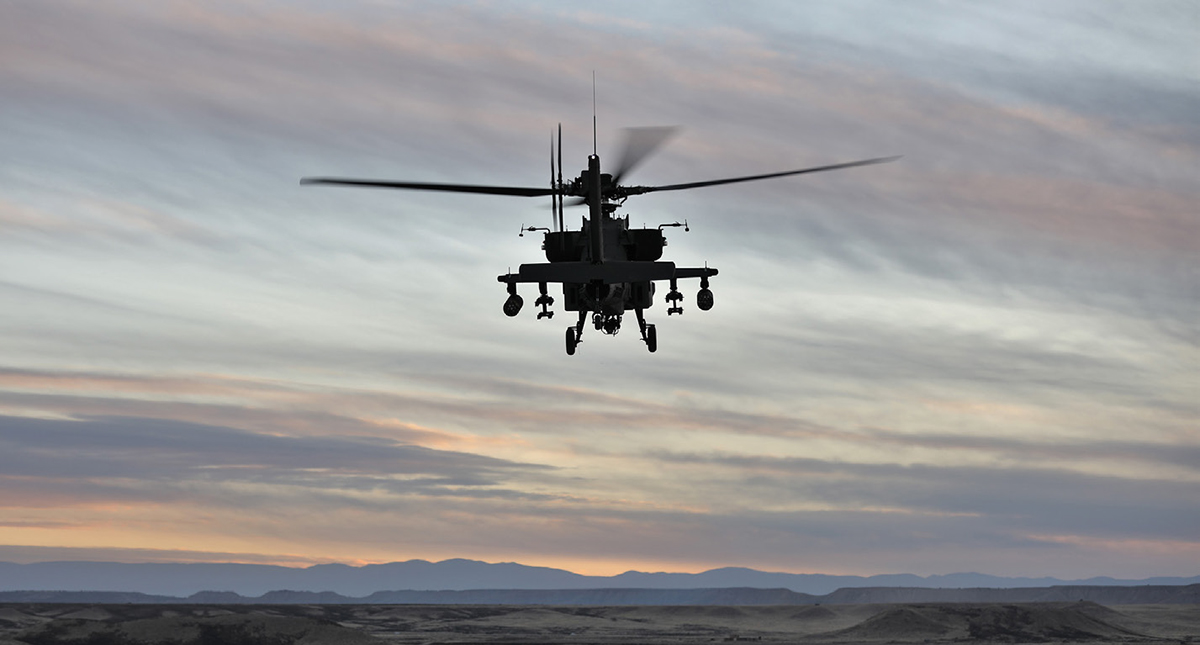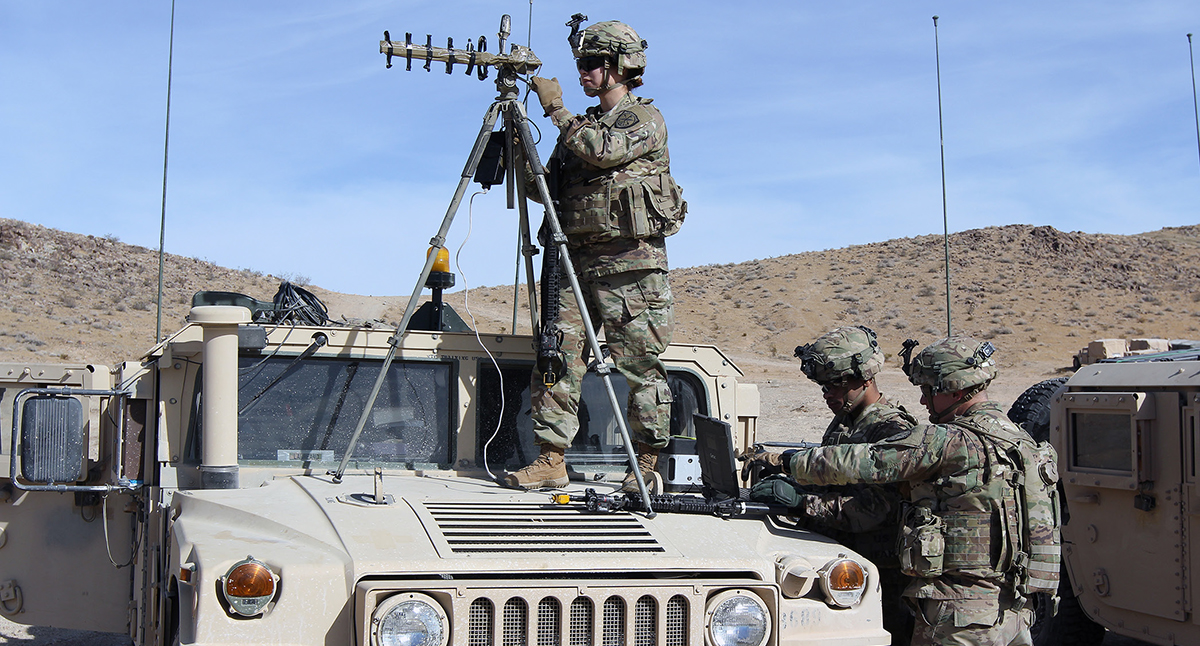Intelligence Reachback
Operations in Support of Combat Aviation Units at the National Training Center
By MAJ Luis E. Llaury, CPT Lynne D. Mooradian, MAJ Kyle J. Pare, CPT Brian L. Matiasmuniz, and CW2 Alex M. Lashbrook
Article published on: October 1, 2024 in the Aviation Digest October-December 2024 Issue
Read Time: < 11 mins

U.S. Army CH-47 Chinook, HH-60, and UH-60 Black Hawk helicopters out of Fort Carson, Colorado, prepare to land at Illesheim Army Airfield, Germany, in support of Atlantic Resolve. U.S. Army photo by SGT Gregory Summers
Introduction
This article outlines key lessons learned from the 4th Combat Aviation Brigade’s (4CAB) Reachback Operations Cell (ROC) in support of Task Force (TF) SABER at the National Training Center (NTC) rotation 24-02. The 4CAB (Ivy Eagles) implemented the ROC concept as a pilot to identify new opportunities best supporting aviation units conducting NTC rotations and reduce critical intelligence (INT) gaps in operations. Ultimately, 4CAB’s ROC was vital to the overall success of TF SABER during both China Lake (CL) iterations—CL1 and CLII—greatly enhancing the commander’s awareness of the operational environment (OE) and increasing lethal effects against enemy conventional threats.
In the initial stages of an NTC rotation, aviation units are required to execute two essential missions: CLI and CLII. Both iterations require the aviation TF to navigate complex mountainous terrain, identify and destroy enemy Integrated Air Defense Systems (IADS), and provide infiltration/exfiltration for friendly Special Forces. Importantly, CLI and CLII allow NTC Observer Coach/ Trainers (OC/Ts) to validate and certify the unit as a multifunctional aviation TF capable of supporting Large-Scale Combat (LSC).
One significant challenge conventional CABs face is the absence of a robust INT warfighting function (IWfF) architecture similar to Army maneuver units. For reference, the modified table of organization and equipment authorizes 4CAB Battalion (BN) S2 (INT) sections to have one O-3 officer-in-charge (OIC), one O-1/O-2 Assistant S2 (AS2), one E-6 Noncommissioned OIC (NCOIC), and two All-source INT Analysts (E-5 and below). The limited manpower significantly impacts the BN S2’s ability to maintain a common INT picture and help drive targeting efforts.
Problem Statement
The proliferation of advanced and emerging long-range precision strike capabilities means that IWfF nodes are increasingly vulnerable to enemy longrange fires when positioned forward (FWD) and out of sanctuary (National Intelligence Council, 2021, p. 11). Additionally, the high potential for electronic warfare (EW) in LSC mandates measures to minimize or conceal a unit’s electromagnetic footprint (Hofstetter & Wojciechowski, 2020, p. 23). To overcome these survivability challenges, the ROC initiative aimed to bolster TF SABER’s capabilities at NTC rotation 24- 02 and test new ways to support FWD elements from protected reach sites.
Providing Reachback Support from Fort Carson, Colorado (FCCO) to TF SABER
The Department of Defense defines reachback as “the process of obtaining products, services, and applications, or forces, or equipment, or material from organizations that are not forward deployed” (Office of the Chairman of the Joint Chiefs of Staff, 2023, p. 157). Similarly, Field Manual 2-0, “Intelligence,” states that “intelligence PED [processing, exploitation, and dissemination] capabilities can perform PED from a deployed location or reach site in theater or the United States” (Department of the Army, 2023, p. 1-25). The critical components of a successful PED reachback initiative are reliable access to necessary INT resources and robust linkages between the INT architecture and FWD command and control nodes. In this context, Ivy Eagles’ leadership strove to test new, innovative ways to support FWD elements from FCCO—resulting in the creation of 4CAB’s ROC.
Phase I: Planning and Preparation
During Phase I, the 4CAB’s S2 and S3 (Operations) OICs focused on establishing expectations for all participating WfFs—INT, Movement and Maneuver (M2), Mission Command (MC), and Fires. The planning phase was vital to determine training objectives, manpower requirements, shift schedules, and operationalizing the Brigade Operations Center (BOC) for reachback support. Critical to the ROC pilot’s success was the 4CAB Commander’s decision to commit personnel and resources from across multiple staff sections under the purview of the S2 OIC.
The ROC concept called for two shift schedules—a morning shift from 0700 to 1500—and an evening shift from 1400–2100. The 1-hour overlap (1400–1500) allowed for shift change handovers, discussions on the latest changes in the OE, and synchronizing efforts across all WfFs. Regarding manpower, the plan called for dedicated personnel to support the initiative in order to protect the ROC from conflicting garrison requirements. In this effort, the IWfF allocated one Geospatial Imagery Analyst (35G), one Geospatial Engineer (12Y), and two All-source Analysts (35F) per shift to leverage a full package of INT capabilities for TF SABER. The M2 WfF provided one Aviation Operations Specialist (15P) per shift to monitor the Joint Battle Command-Platform (JBC-P) and maintain a common operating picture. Fires, to include the Cyberspace and Electromagnetic Activities (CEMA) section, provided two Spectrum Managers (17J) per shift to enhance TF SABER’s lethal and non-lethal effects against conventional IADS threats (Figure). One critical task during the planning phase was establishing communications with TF SABER and the 52D Infantry Division (52ID). In this regard, MC played a pivotal role in building the required network infrastructure inside the BOC, thus enabling the ROC to begin reachback operations.

Figure. Reachback operations cell in 4CAB’s BOC (Figure provided by 4CAB, 2024).
One critical task during the planning phase was establishing communications with TF SABER and the 52D Infantry Division (52ID). In this regard, MC played a pivotal role in building the required network infrastructure inside the BOC, thus enabling the ROC to begin reachback operations.
From the early stages, the commander’s intent for building the communications architecture was to maximize 4CAB’s organic capabilities. Therefore, the 4CAB S6 (signal and communications officer) used the brigade’s sole Joint Network Node (used for remote, satellite-based communication) integrated with the Battle Command Common Services1 to act as the ROC’s local access point for engineering and connectivity. Positioned at the 4CAB Headquarters, both sets of stacks facilitated the actual physical transport layer through logical fiber connections from FCCO to Fort Irwin, California, and essential services like email, shared drives, and communication platforms (e.g., Skype and Spark). Ultimately, the network architecture provided access to 52ID’s critical services to include SharePoint, ShareDrive, and Enterprise platforms like ChatSurfer that “connects you with people on chat servers across multiple networks” (National Reconnaissance Office, n.d.)—all critical requirements to enable reachback operations.
Notably, the process required establishing a network transport through the Regional Hub Node (RHN) at Camp Roberts, California, leveraging its connection to 4ID’s Global Agile Integrated Transport (GAIT) switch.2 The connection was necessary to enable cross-communication between 4CAB and 52ID. Crucial to this successful integration was a collaborative effort between 4CAB Network Operations (NetOps), 4ID NetOps, and 52ID’s network team. Sharing network diagrams and close collaboration allowed both sides to whitelist internal subnets, thus establishing a trust connection between the respective server stacks. The trust relationship enabled user access across both networks, therefore removing the need for new user account creations on the 52ID domain.
As expected, MC faced some challenges during the process—building rules, configuring firewalls, and defining network routes to enable the connection with the RHN and subsequently, 52ID. Overcoming these obstacles demanded increased manpower support, requiring approximately 3 working weeks of focused networking to build the required infrastructure. Importantly, brigade NetOps sections should be aware that division G6 (communications and information technology) support is crucial to enable reachback connectivity with units deployed to combat training centers. Even with extensive support, one limitation remained—MC was unable to establish internet protocol-based voice comms with TF SABER due to conflicting mission configurations and the use of satellite communications. To overcome this challenge, 4CAB established a redundant Primary, Alternate, Contingency, and Emergency (PACE) plan that included JBC-P and tactical satellite communications

A UH-60 Black Hawk helicopter assigned to Task Force Saber makes a banking maneuver in the mountains of Fort Carson, Colorado. U.S. Army photo by SGT Keven Parry.
Phase II: Training
The second phase aimed to develop initial products for the ROC pilot, familiarize ROC personnel with the CL scenarios, and train personnel to conduct reachback operations. The IWfF prepared analog/digital maps, consolidated INT products from previous NTC rotations, and drafted a Graphic INT Summary (GRINTSUM) template.
To note, 4CAB prioritized training INT Analysts and CEMA 17Js on the Fusion Analysis and Development Effort/MultiINT Spatial Temporal (FADE/MIST) Toolsuite—an INT platform developed for “geospatial data visualization and analysis application,” (Consolidated Analysis Center [CACI], 2021) to provide battlespace awareness using the detectable signatures associated with enemy radar systems (Flick, 2021). Additional training included INT preparation of the OE, terrain analysis, basics of signals INT (SIGINT), and electromagnetic order of battle (EOB) development.
Phase III: Execution
The Execution Phase consisted of providing dedicated reachback support to TF SABER over the span of 5 days (30 October–03 November 2023) to specifically cover both CLI and CLII iterations. The phase began with a communications exercise, intended to test the PACE plan for successful communications with FWD elements at the NTC.
Secret Internet Protocol Router Network (SIPRNet) ChatSurfer was the primary (PACE) method of communication and INT product exchange between the ROC and TF SABER. In addition, the ROC monitored chat rooms for 52ID G2 (military INT staff), 3D Armored Brigade Combat Team’s (3ABCT) Brigade INT Support Element, and 3ABCT INT Collection Manager to maintain situational awareness and access relevant reporting. The NTC Warrior Portal—a SIPRNet SharePoint site dedicated to supporting participating units—acted as the alternate (PACE) method of INT product dissemination. Of note, the NTC Warrior Portal was non-missioncapable throughout most of the operation. Therefore, the ROC relied on the contingency (PACE)—SIPRNet email— to disseminate INT products, since it proved highly reliable and faster than sharing products through ChatSurfer. The ROC rarely used its emergency (PACE) method—JBC-P and SIPR Voice over Internet Protocol.
The ROC concept contained three lines of effort (LOEs)—Geospatial INT (GEOINT), CEMA, and Fusion. Regarding GEOINT, 35Gs and 12Ys provided initial products depicting vertical obstacles, power lines, key terrain, and potential helicopter landing zones (Erskine et al., 2022). Subsequent products concentrated on identifying known enemy radars, surface-to-air missile systems, and jammers within the OE. Importantly, GEOINT Analysts worked closely with All-source Analysts to determine the composition, disposition, and capabilities of enemy IADS
The second LOE—CEMA—consisted of 17Js drafting Joint Tactical Air Strike Requests (JTARs) for TF SABER, synchronizing information on enemy radars and jammers with the All-source Analysts, and conducting frequency spectrum analysis. During the execution of CLI and CLII, JTARs played a pivotal role in ensuring TF SABER had convergence windows to enable lethal and non-lethal effects against enemy radars. Moreover, CEMA analysis provided valuable contributions to the IWfF in determining what simulated enemy systems were associated with real emitters present in the CL training area.

An AH-64 hovers while acquiring targets during aerial gunnery training at Fort Carson, Colorado. U.S. Army photo by SSG Jeremy Ganz.
As the third LOE, the Fusion Cell synchronized and analyzed all received INT from GEOINT, Electronic INT (ELINT), and CEMA. In this effort, All-source Analysts worked closely with the 17Js to monitor FADE/MIST, “which detects patterns of life and anomalies within large volumes of geospatial data” (CACI, Inc., 2021). All-source Analysts then used various tools and known enemy doctrine to assess the composition and disposition of the enemy’s IADS architecture and most importantly, determine the most likely enemy unit emitting the signals. The Fusion Cell provided its overall assessment—derived from fused ELINT, communications INT, and open-source INT—to TF SABER through bi-daily GRINTSUMs. During execution, the ROC also maximized FCCO’s Foundry platform (INT training readiness program) on multiple occasions. The 4CAB S2 submitted requests for information to the Foundry cadre for items falling outside of the unit’s organic capabilities, particularly SIGINT and ELINT.
In general, ROC workflow began with the ROC OIC establishing communications with the TF SABER S2 OIC/ NCOIC via ChatSurfer to determine priorities and product requirements. Discussions focused on identifying INT cutoff times for GRINTSUMs, GEOINT requirements, and any changes in the OE. Throughout the execution of CLI and CLII, All-source Analysts provided near-real time (NRT) support to TF SABER via ChatSurfer, to identify enemy electronic emissions, radar/jammer types, and associated weapons systems (Flick, 2021). To emphasize, monitoring FADE/MIST for TF SABER became the ROC’s most significant contribution during this phase, since TF SABER experienced limited SIPRNet connectivity and inconsistent FADE/MIST access.
Phase IV: Recovery and Assessment
Key tasks during this phase included staging and preparing equipment for future operations, conducting after-action reviews (AARs), and updating standard operating procedures. Measures of Performance and Effectiveness for the ROC pilot derived directly from the 4CAB and TF SABER AARs.
Key Successes
- Establishing early communications with OC/T personnel at NTC proved vital during the planning phase, particularly in identifying requirements and developing the architecture for reachback support.
- Providing TF SABER with bi-daily GRINTSUMs, EOB updates, and Radar Smart Cards (pocket card/instruction aid) proved highly valuable during planning cycles. Importantly, the additional support allowed TF SABER’s IWfF to spend more time enabling targeting efforts and advising the commander.
- Developing a detailed PACE plan was crucial to overall mission success. During the planning phase, 4CAB’s WfFs— specifically M2, INT, and MC—worked closely to identify the best available platforms and tools for ROC operations.
- Continuous monitoring of FADE/ MIST and ChatSurfer directly impacted the overall success of TF SABER, particularly when FWD elements experienced poor network connectivity.
- Maximizing FCCO’s Foundry platform enabled in-depth analysis of enemy IADS architecture and expanded the ROC’s capabilities, particularly in SIGINT and ELINT.
Lessons Learned
While the ROC pilot generated multiple successes, it also presented some challenges. One of the most significant oversights during the planning phase was not identifying all TF SABER requirements prior to departing for the NTC. This led to ROC leadership predicting requirements, which in some instances, resulted in redundant efforts. Thus, establishing a working group (WG) prior to NTC deployment is necessary to synchronize requirements, set expectations, streamline communications, and identify potential friction points during execution. Ideally, the ROC OIC chairs the WG with representation from all participating brigade WfFs and the supported unit.
Additional lessons learned
- Effective knowledge management is critical to success—from organizing 52ID’s operations orders and fragmentary orders to building an effective SharePortal for product repository.
- Prior to execution, the ROC lacked essential INT products like Smart Cards for enemy radars, jamming capabilities, enemy order of battle, and EOB. Ideally, Analysts build these products during Phase II (Training) to ensure ROC personnel have the necessary tools entering Phase III (Execution).
- Fusion Analysis and Development Effort/MIST training for All-source Analysts and CEMA 17Js is vital to mission success. The Foundry platform offers a 40-hour FADE/MIST course to train analysts in NRT tracking of enemy radar systems and jammers—a critical capability in LSC.
- Mission Command—Aviation brigades planning to conduct similar reachback support must work closely with higher echelons to establish connectivity. Specifically, RHN and G6 support are crucial to build the network architecture required for reachback operations.

Specialists from the Expeditionary Cyber Support Detachment (Fort Eisenhower, Georgia) provide offensive cyber operations during an NTC rotation. U.S. Army photo by Steven Stover.
Conclusion
The ROC pilot was highly successful in delivering INT, M2, Fires, and CEMA support to TF SABER. Holistically, the initiative added valuable manpower for critical capabilities in LSC—particularly in locating the enemy’s IADS architecture and driving targeting efforts. Despite the multiple challenges faced, the ROC proved to be an effective use of a protected sanctuary node, providing valuable INT to FWD deployed units and practicing new methods of command post survivability. Moving ahead, the ROC concept will expand to provide reachback support during entire NTC rotations. While new challenges will arise, particularly in establishing connectivity with the supported BCTs, 4CAB’s ROC pilot proved that supporting FWD elements is not only possible but perhaps a necessity in LSC.
Notes
1. “Battle Command Common Services and Tactical Server Infrastructure provide a powerful and capable server suite for virtualizing mission command focused applications while ensuring commonality to the command post hardware infrastructure” (U.S. Army, 2018).
2.“GAIT is essentially a router that allows equipped units the ability to connect point to point with each other across the world without having to go through the enterprise”(Pomerleau, 2020).
References
4th Combat Aviation Brigade. (2024). Reachback operations cell in4CAB’s BOC.
Consolidated Analysis Center (CACI), Inc. (2021, May).Multi-INT Spatial Temporal (MIST) toolsuite discover hidden patterns within complex data. https://www.caci.com/sites/default/files/2021-05/F367_MIST_FADE_210510.pdf
Department of the Army. (2023). Intelligence (Field Manual 2-0). https://armypubs.army.mil/epubs/DR_pubs/DR_a/ARN39259-FM_2-0-000-WEB-2.pdf
Erskine, J., Oxendine, C., Wright, W., O’banion, M., & Philips, A. (2022). Evaluating the relationship between data resolution and the accuracy of identified helicopter landing zones (HLZs). Applied Geography (139), 1-10. https://doi.org/10.1016/j.apgeog.2022.102652
Flick, R. R. (2021, November). Winning the counterland battle by enabling sensor-to-shooter automation.Air Land Sea Application Center. https://www.alsa.mil/Portals/9/Documents/articles/211101_ALSA_Article_Flick_Counterland.pdf
Hofstetter, J., & Wojciechowski, A. (2020). Electromagnetic spectrum survivability in large-scale combat operations. . Infantry, 109(4), 21-24. https://www.moore.army.mil/infantry/magazine/issues/2020/Winter/PDF/7_Hofstetter_EW_txt.pdf
National Intelligence Council. (2021, April). The future of the battlefield (NIC-2021-02493). Global Trends, 1-12, https://www.dni.gov/files/images/globalTrends/GT2040/NIC-2021-02493--Future-of-the-Battlefield--Unsourced--14May21.pdf
National Reconnaissance Office. (n.d.). ChatSurfer https://chatsurfer.nro.mil/#/
Office of the Chairman of the Joint Chiefs of Staff. (2023). Reachback. In DoD dictionary of military and associated terms.. Retrieved April 2024, from https://jdeis.js.mil/jdeis/new_pubs/dictionary.pdf
Pomerleau, M. (2020, January 13). Army increases ‘GAIT’ to improve network connectivity. C4ISRNET https://www.c4isrnet.com/battlefield-tech/2020/01/13/armys-increases-gait-to-improve-network-connectivity/
U.S. Army. (2018, June 29). Strategic mission command. https://www.army.mil/article/168124/strategic_mission_command
Authors
MAJ Luis Llaury, the 4CAB S2, graduated from Georgetown University with a Master of Arts in Security Studies. He has served in multiple SIGINT positions throughout his career, most recently serving as a Joint Cryptologic Planner and Operations Officer in the 742D Military INT BN. Previous assignments include the 743D Military INT BN (Buckley Space Force Base, Colorado) and the 2D Cavalry Regiment (Vilseck, Germany).
CPT Lynne Mooradian, a Military INT officer, graduated from the United States Military Academy in 2020 with a Bachelor of Science degree in Mechanical Engineering. Following her graduation, she earned a Master of Philosophy degree in Biotechnology from the University of Cambridge and a Master of Science degree in Biosecurity from the University of Edinburgh. She currently serves as the 4CAB AS2.
MAJ Kyle Pare, the 4CAB S6, has served for 11 years in a variety of Signal positions. His most recent assignment was as the S6 for Task Force Sinai, the American contingent of the Multinational Force and Observers in Sinai, Egypt. He has also served as the company commander at the Enterprise Satellite Communications Gateway-Landstuhl, Germany, and as a BN S6 in 4CAB.
CPT Brian Matiasmuniz, the 4CAB S6 NetOps OIC, has served for 12 years in a variety of combat arms and Signal positions. His most recent assignment is a Data Systems Engineer for the 4CAB. He has also served as an Executive Officer and Platoon Leader for a one station unit training BN on Fort Moore, Georgia. Previously, he was stationed in the 2D Cavalry Regiment, Germany, where he worked with multiple nations in support of a North American Treaty Organization Multinational Battle Group.
CW2 Alex Lashbrook currently serves as a 350F All-source INT Technician in the 4CAB S2 section. He joined the U.S. Navy in 2014 and served as an Operations INT Analyst with Amphibious Forces, 7th Fleet (Western Pacific) and an Expeditionary Warfare INT Specialist with Theater Special Operations Command, U.S. Southern Command. He was appointed as a U.S. Army WO in 2022 and served as the Brigade INT Support Element Chief for 1st Stryker Brigade, 4th Infantry Division prior to his tenure at 4CAB.